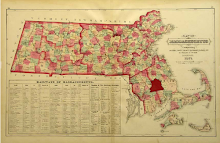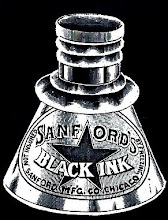 On Memorial Day, as fire gutted a large portion of the historic Central Congregational Church on South Main Street, onlookers stood watching in shock and disbelief while flames licked at the base of the steeple, threatening to consume the church which for so many held a deeply-rooted connection to the Town of Middleborough and its history. Despite the disturbing novelty of the scene, it was one which had been witnessed previously in Middleborough, over 120 years earlier when fire utterly destroyed the Central Baptist Church.
On Memorial Day, as fire gutted a large portion of the historic Central Congregational Church on South Main Street, onlookers stood watching in shock and disbelief while flames licked at the base of the steeple, threatening to consume the church which for so many held a deeply-rooted connection to the Town of Middleborough and its history. Despite the disturbing novelty of the scene, it was one which had been witnessed previously in Middleborough, over 120 years earlier when fire utterly destroyed the Central Baptist Church.The original Central Baptist Church had been constructed on the site of the present building on Nickerson Avenue in 1828, the culmination of a long effort by local church leaders to establish their own church in the then burgeoning Four Corners area. The church, which replaced an earlier chapel used by the parish, was a symbol of the aspirations of the local Baptist community which had been so influential in the growth of Middleborough center.
 Until 1847 when the Central Congregational Society was formed, the Central Baptist Church remained the sole church at Middleborough Center. Accordingly in those nearly twenty years, it established for itself a primacy of place within the lives of local residents, many of whom were members of the parish and all of whom, in time, would have a connection with the building. That connection came in 1847 when the identity of Four Corners residents was wedded to the church with the installation of a town clock in the church steeple, an action undertaken at the behest of the town which sought to use the church’s steeple as the highest structure then at Middleborough Center. Little appreciation, however, was probably given the clock until the bitterly cold afternoon of January 22, 1888, when the church was destroyed by fire, and the town clock with it.
Until 1847 when the Central Congregational Society was formed, the Central Baptist Church remained the sole church at Middleborough Center. Accordingly in those nearly twenty years, it established for itself a primacy of place within the lives of local residents, many of whom were members of the parish and all of whom, in time, would have a connection with the building. That connection came in 1847 when the identity of Four Corners residents was wedded to the church with the installation of a town clock in the church steeple, an action undertaken at the behest of the town which sought to use the church’s steeple as the highest structure then at Middleborough Center. Little appreciation, however, was probably given the clock until the bitterly cold afternoon of January 22, 1888, when the church was destroyed by fire, and the town clock with it.Conflicting reports remain regarding who first noticed the fire which was later attributed to an overheated chimney. Mrs. Elisha T. Jenks, then inside the building with the Sunday School class, is said to have reported the fire after she saw smoke blowing past the window. Another report states that it was a different member of the class who smelled smoke and upon investigating discovered the blaze.
While the Sunday School was being immediately evacuated from the church, Merrick was apparently having some difficulty in convincing the firemen of the gravity of the situation and they are reported as having been “at first rather incredulous”. Nonetheless, the engine responded (though drawing it even the short distance was difficult given the snow which covered the ground) and with five and a half minutes a chemical stream was applied to the building and within ten minutes a stream of water.
 Water was played upon the roof around the chimney, but by that time, the fire had spread the entire length of the building between the ceiling and the roof. Dense smoke and intense heat beat back firefighters who, unable to quench the flames focused on saving adjoining buildings, including the former Peirce Academy building and Thatcher’s print shop. Embers drifted as far as South Main Street, momentarily setting the roof of Charles Drake’s House (on the site of the Mayflower Bank) ablaze. Ice and freezing temperatures made the task of firemen particularly difficult and especially dangerous. One firefighter, Alonzo Norris, was injured "by the falling of a hose nozzle, cutting a severe scalp wound, but no serious results are apprehended. A few days of confinement will probably bring him around all right. One or two others were somewhat bruised but not seriously."
Water was played upon the roof around the chimney, but by that time, the fire had spread the entire length of the building between the ceiling and the roof. Dense smoke and intense heat beat back firefighters who, unable to quench the flames focused on saving adjoining buildings, including the former Peirce Academy building and Thatcher’s print shop. Embers drifted as far as South Main Street, momentarily setting the roof of Charles Drake’s House (on the site of the Mayflower Bank) ablaze. Ice and freezing temperatures made the task of firemen particularly difficult and especially dangerous. One firefighter, Alonzo Norris, was injured "by the falling of a hose nozzle, cutting a severe scalp wound, but no serious results are apprehended. A few days of confinement will probably bring him around all right. One or two others were somewhat bruised but not seriously."Disregarding the temperature, crowds gathered along Center Street and in the rear of the Town Hall to observe the destruction of the church with the most dramatic moment being the crashing in of the 128 foot high steeple, weighted with both bell and town clock.
“The bell in falling lodged upon the gallery floor, immediately over a solid post and lies there, broken, and partially melted. The clock in its fall is almost wholly lost sight of in the mass of debris, but few traces of it having yet been found…. The hands of the clock stopped at 12.35.”
Later, the local fire department would come into some criticism for their conduct of operations at the scene of the fire. While the exact nature of the complaints lodged against the firefighters has not been left on record, a spirited rebuttal to the criticism has.
 The loss of their church was devastating for the closely knit members of the society. More broadly, the 1888 loss of the Central Baptist Church and with it the town clock which it housed, was a psychological blow for the Four Corners community, so accustomed had the become to the presence of the town clock in their lives, its bell tolling the hours day in and day out. “The ‘town clock’ was a familiar feature, which shall be sadly missed. Many eyes have unconsciously sought its accustomed place for the time today, but alas, no intelligence could be gained.”
The loss of their church was devastating for the closely knit members of the society. More broadly, the 1888 loss of the Central Baptist Church and with it the town clock which it housed, was a psychological blow for the Four Corners community, so accustomed had the become to the presence of the town clock in their lives, its bell tolling the hours day in and day out. “The ‘town clock’ was a familiar feature, which shall be sadly missed. Many eyes have unconsciously sought its accustomed place for the time today, but alas, no intelligence could be gained.”.






















+of+Smoky+Mountains+018.jpg)
1 comments:
Interesting!! Thank you.
Post a Comment